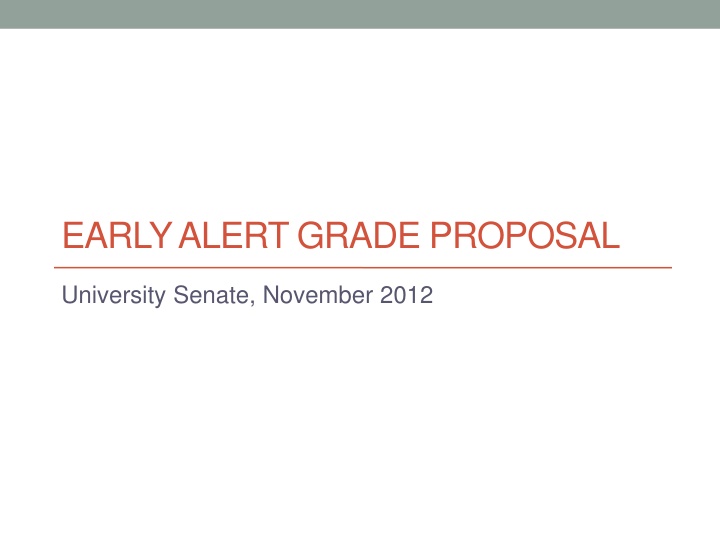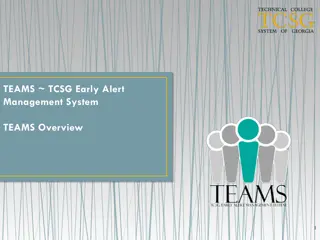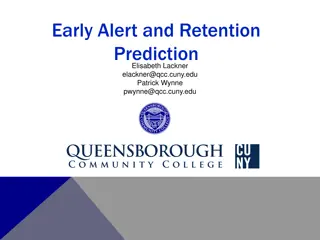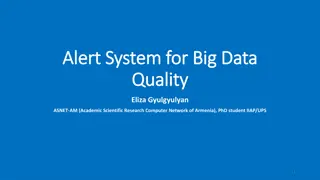EARLY ALERT GRADE PROPOSAL
Implementing an early alert system with midterm grade reporting can significantly improve student retention and graduation rates. Providing feedback on academic performance, especially to first-year students, can help them navigate the challenges of college-level work and seek necessary support services. Discover what peer universities do regarding midterm grade reporting and learn from successful practices to support student success.
Download Presentation

Please find below an Image/Link to download the presentation.
The content on the website is provided AS IS for your information and personal use only. It may not be sold, licensed, or shared on other websites without obtaining consent from the author.If you encounter any issues during the download, it is possible that the publisher has removed the file from their server.
You are allowed to download the files provided on this website for personal or commercial use, subject to the condition that they are used lawfully. All files are the property of their respective owners.
The content on the website is provided AS IS for your information and personal use only. It may not be sold, licensed, or shared on other websites without obtaining consent from the author.
E N D
Presentation Transcript
EARLY ALERT GRADE PROPOSAL University Senate, November 2012
Existing Grading Policy Instructors shall determine the policy regarding grading which they feel is best for the course. This policy shall be presented to the class, in writing, at the beginning of the term and will govern the actions of the instructor in the course. --from the Auburn University Policy on Class Attendance https://sites.auburn.edu/admin/universitypolicies/Policies/PolicyonClassAttendance.pdf
Problems Students need feedback on their academic performance. First-year students in particular need feedback to help them adjust to the complexities of college-level academic work. Students may need a push to get them to take advantage of a professor s office hours, tutoring, or other services they may need to help them succeed academically
Results of Poor Academic Performance in the First Year Being placed on Academic Warning Undermined confidence in ability to succeed at Auburn A deep hole it may be very hard to dig out of 4-year graduation rate: 42% 6-year graduation rate: 68% The Improved Graduation Rates Task Force Report (2008) noted the importance of midterm grades in establishing an early alert system that would provide for intervention with at-risk students. http://www.auburn.edu/academic/provost/pdf/IGR_Report_12-19-2008.pdf
What our peers do University of Alabama Midterm grades required in 100- & 200-level courses University of Arkansas Midterm grades required for 1000- & 2000-level classes, approx. 2 weeks prior to midterm date. Clemson University Faculty encouraged to provide freshmen with midterm grades University of Georgia Faculty are requested to report midterm grades by one day prior to midterm LSU Midterm grades reported for all students online Mississippi State University Encouraged, but not required, for all students University of Missouri Midterm grades not required University of South Carolina Midterm grades not required Texas A&M Faculty report midterm grades for students with < 30 hours, students <2.0 GPA, student athletes, and students in language assistance programs
The Process thus far Improved Graduation Rates Task Force Report (2008) Identified an early alert system (including midterm grade reporting) as a best practice to aid in student retention and graduation Midterm Pilot Project (2010-11) Explored assigning midterm grades in Banner for students earning D/F grades in selected core Biology, Math, and History courses; midterm grades also assigned for students in First-Year Seminar (UNIV) classes. Follow-up provided by Educational Support Services & Undergraduate Advising/Counseling Center, and instructors Academic Affairs Committee (summer 2012) Considered policy options and made a recommendation to the Senate leadership. Core Curriculum and General Studies Committee (fall 2012) Asked by the Senate leadership to review the proposal and make a recommendation to the Senate.
The Proposed Policy In order to facilitate the adjustment of students to the rigors of Auburn University course work, faculty teaching core courses must record in Banner an early alert grade for all students enrolled in those classes one week prior to midterm. This process will permit students to seek tutoring or take other action before the midterm drop deadline.
Three Important Parts of the Proposed Policy Core courses because of the likelihood of early career students enrolled in them In Banner so that reports may be run and shared with those who will follow-up with students. In order to facilitate the adjustment of students to the rigors of Auburn University course work, faculty teaching core courses must record in Banner an early alert grade for all students enrolled in those classes one week prior to midterm. This process will permit students to seek tutoring or take other action before the midterm drop deadline. One week prior so that students have a chance to take action.
QUESTIONS? Constance Relihan relihco@auburn.edu 4-4900
Additional data Midterm policy 1st-year Retention* 4-yr grad rate* 6-yr grad rate* Median ACT* Auburn University Not required 86% 35.7% 66.4% 26 University of Alabama 100- & 200-level courses 83% 37.9% 67.3% 24.5 University of Arkansas 1000- & 2000-level classes, approx. 2 weeks before midterm 83% 34.5% 57.9% 26 Clemson University All freshmen 90% 49.7% 76.2% 26.5 University of Georgia Faculty requested to report prior 94% 51.9% 79.8% 26.5 LSU all students 84% 26.2% 58.8% 25.5 Mississippi State Encouraged 82% 28.4% 58% 23.5 University of Missouri not required 85% 43.1% 69.4% 25.5 Univ. of South Carolina not required 87% 45.8% 67.6% 26 Texas A&M Special populations 93% 46.2% 79.9% 27 * 2010 data from www.collegeresults.org













